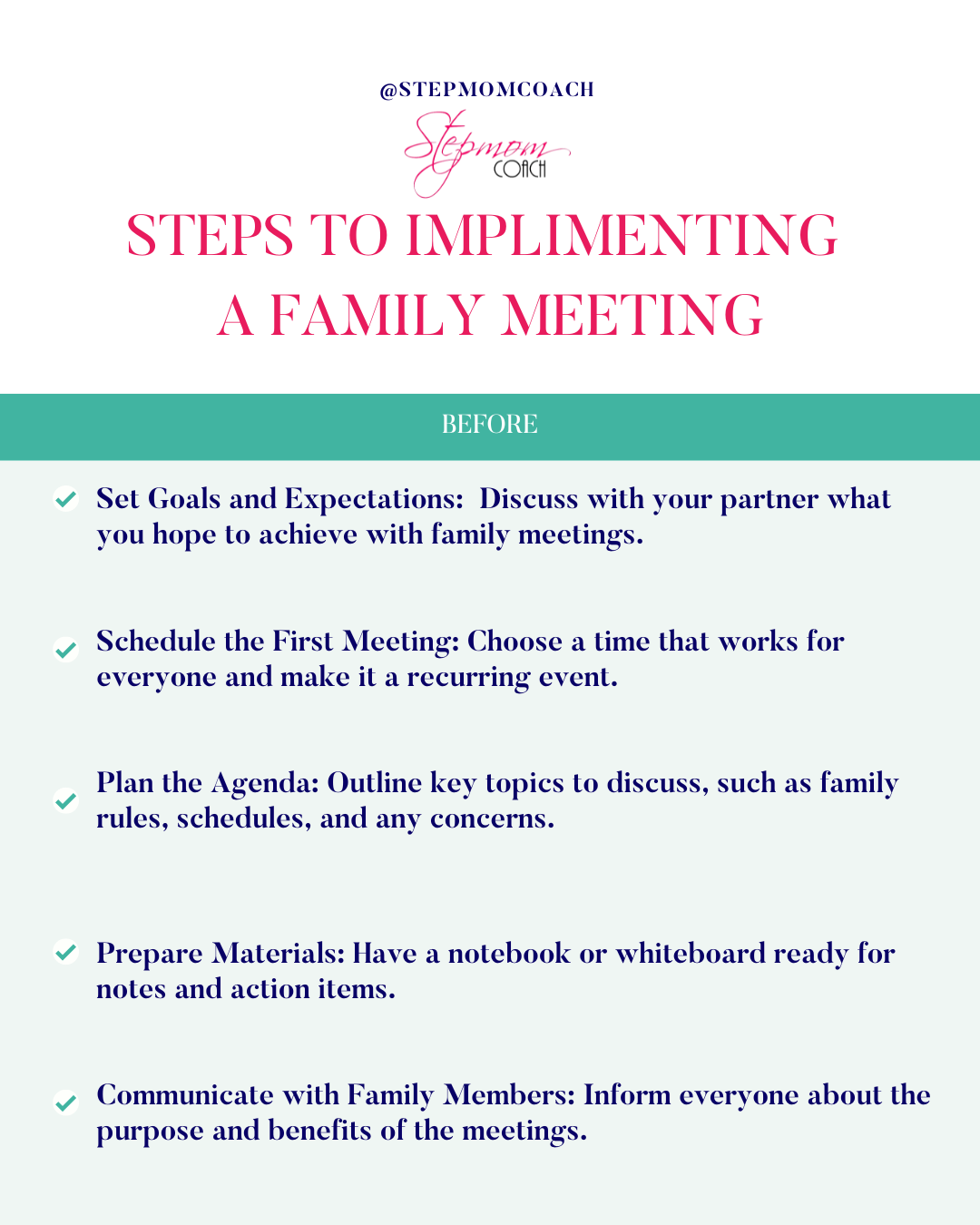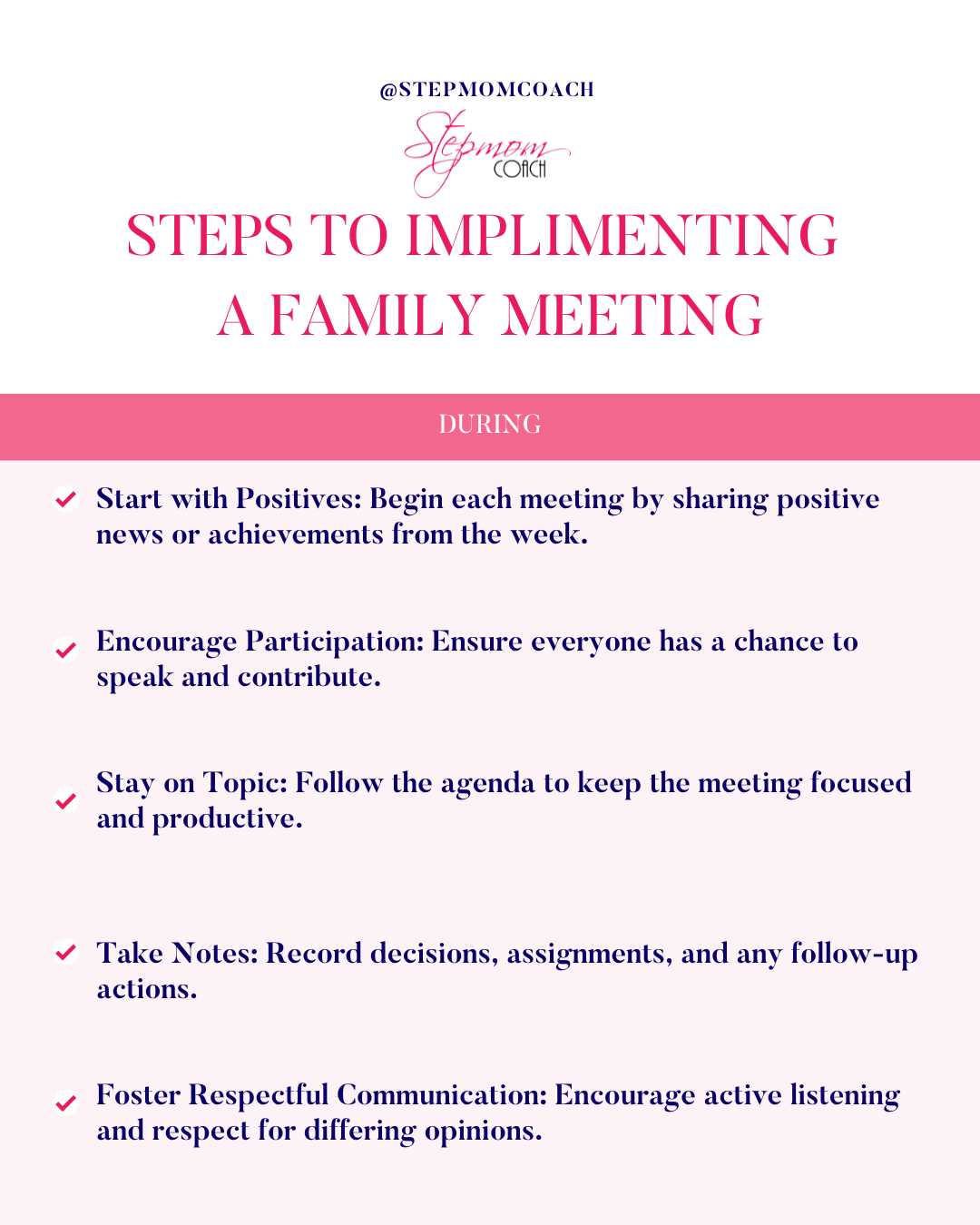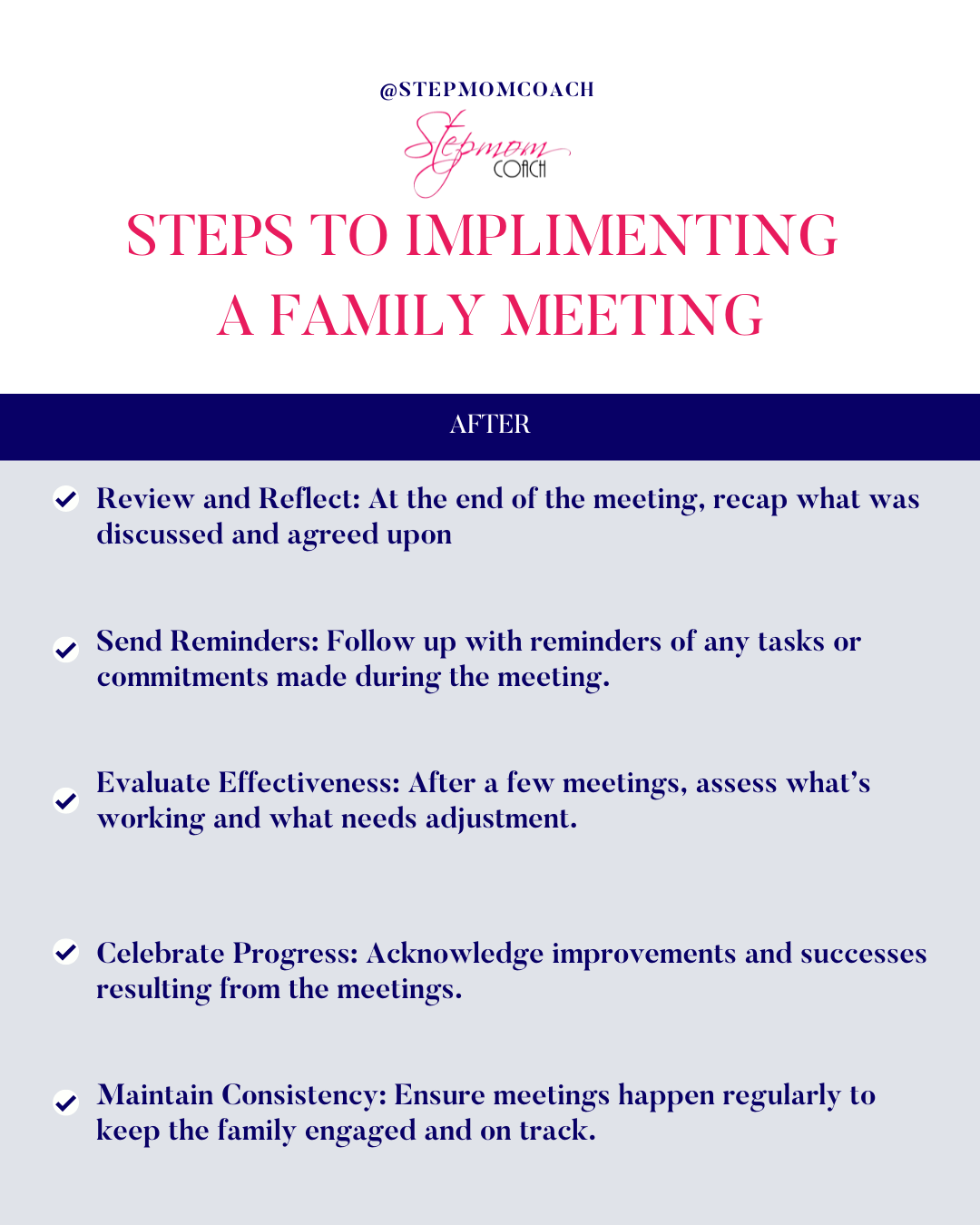
Transform Your Stepfamily
with Effective Family Meetings
In our early years as a stepfamily, I struggled to connect with my stepdaughters, avoid overprotecting my son, and create a strong and healthy relationship with my husband. One tool that worked for us—and for many stepfamilies I’ve worked with—was implementing regular family meetings. These meetings provide a structured way to communicate, share, and grow together as a family. There are many ways to hold family meetings, and I’m sharing one approach to effectively implement family meetings in your stepfamily, focusing on what to do before, during, and after the meetings.
Before the Meeting: Setting the Stage
1. Set Goals and Expectations: One of the things Bernard and I did was discuss what we hoped to achieve with these meetings. Here are some examples of what to look for:
- Are you looking to improve communication, address specific issues, or simply ensure everyone is on the same page? Having clear goals will give your meetings direction and purpose.
- Example: One stepfamily I worked with wanted to reduce the number of arguments about household chores. They set a goal to create a fair chore schedule during their meetings.
2. Schedule the First Meeting: Find a time that works for everyone in the family and make it a recurring event. Consistency is key, so try to stick to the schedule as much as possible.
- Story: Sarah, a stepmom of two, found that Sunday evenings worked best for her family because it allowed them to plan for the week ahead without the rush of weekday activities.
3. Plan the Agenda: I had a tendency to bring the “kitchen sink” into our conversations, which in turned would exhaust Bernard. By outlining the key topics we wanted to address during the meeting, we made it more practical. This could include family rules, upcoming schedules, and any concerns or ideas that family members want to bring up. Having a plan helps keep the meeting organized and productive.
- Tip: Use a shared online calendar like Google Calendar or a family bulletin board pinned on the refrigerator to keep track of topics and ensure everyone can add items for discussion.
4. Prepare Materials: Bernard loves using his yellow legal pad to take notes. This way, whatever decisions and action items were discussed were recorded. If either one of us happened to forget what was agreed upon, we had the notes to refer back to, keeping us accountable.
- Example: In one family, the stepmom used a colorful notebook to make note-taking more fun and engaging for the kids.
5. Communicate with Family Members: I came to realize that not everyone enjoys family meetings. There’s often a feeling that someone is in trouble. This is why it’s important to let everyone know the purpose and benefits of the meetings. Explain that this is a safe space for everyone to share their thoughts and feelings, and that their input is valuable.
- Story: When explaining the idea of family meetings to her stepkids, Lisa emphasized how it would be a space for them to voice their opinions and feel heard, which helped them buy into the concept.

During the Meeting: Making It Work
1. Start with Positives: A strategy I use and share with my clients often is to begin each meeting by sharing positive news or achievements from the past week. This sets a positive tone and encourages everyone to participate.
- Example: One family starts their meetings with a "highlight reel," where each member shares one positive thing that happened to them during the week.
2. Encourage Participation: Do you have someone who tends to “hog” the conversation? Make sure everyone has a chance to speak and contribute. You want to hear from each family member so that they feel valued and heard.
- Tip: Use a "talking stick" or another object that the speaker holds, ensuring that everyone gets their turn without interruptions.
3. Stay on Topic: As I mentioned above, I sometimes brought the “kitchen sink” to the table. That’s why following the agenda was helpful and productive. If new issues arise, note them down for the next meeting instead of derailing the current discussion.
- Story: During one meeting, a heated debate about screen time rules was tabled for the next meeting, allowing the current discussion on vacation plans to proceed smoothly.
4. Take Notes: There are times when we think we remember one thing, but others hear something different. Record decisions, assignments, and any follow-up actions. This ensures that everyone knows what was agreed upon and what needs to be done.
- Example: Using a whiteboard, one family documented action items in real-time, which helped in visualizing responsibilities and deadlines.
5. Foster Respectful Communication: Encourage active listening and respect for differing opinions. Remind everyone that the goal is to improve family dynamics, not to place blame or argue.
- Tip: Establish ground rules, such as no interrupting and no blaming, to maintain a respectful and constructive atmosphere.

After the Meeting: Keeping the Momentum
1. Review and Reflect: At the end of the meeting, recap what was discussed and agreed upon. This reinforces the decisions made and ensures clarity.
- Example: One stepmom ends each meeting with a quick summary of the key points and asks if anyone has questions or needs clarification. She then thanks everyone for attending the meeting.
2. Send Reminders: Follow up with reminders of any tasks or commitments made during the meeting. This helps in ensuring that everyone follows through on their responsibilities.
- Story: Jane, a stepmom, sends a weekly text reminder to her family about their tasks, helping them stay on track.
3. Evaluate Effectiveness: After a few meetings, assess what’s working and what needs adjustment. Are the meetings too long? Does everyone have a chance to share? This can be done during the meeting or as a separate discussion between parents.
- Example: After three months of meetings, one family held a special session to evaluate their progress and made necessary tweaks to their agenda and meeting format.
4. Celebrate Progress: We all like to feel there’s progress. Sometimes we need reminders. Celebrating these small victories can boost morale and show that the meetings are making a positive impact.
- Tip: Create a "family success board" where you can visually track and celebrate accomplishments. This is great for encouraging kids to stay on task with chores.
5. Maintain Consistency: Ensure that meetings happen regularly to keep the family engaged and on track. Consistency helps in building trust and a sense of routine.
- Story: By sticking to their bi-weekly meetings, the Johnson family saw a significant improvement in communication and cooperation among all members.

We have seen how family meetings helped us and many of the stepfamilies I’ve worked with become a transformative tool, helping to improve communication, resolve conflicts, and build stronger bonds. By setting clear goals, encouraging participation, and maintaining consistency, you can create a positive and productive environment for your family. Start implementing these steps today and watch as your family grows closer and more connected.
Feel free to reach out to me if you need more personalized guidance on setting up family meetings or navigating stepfamily dynamics. Together, we can create a harmonious and loving environment for your family.